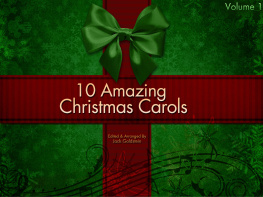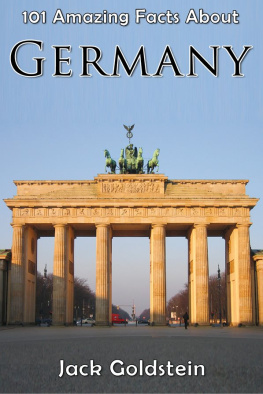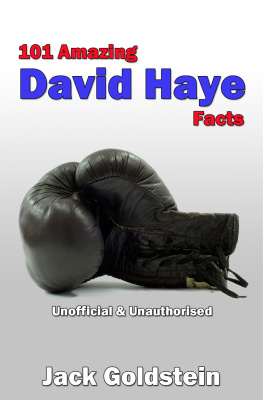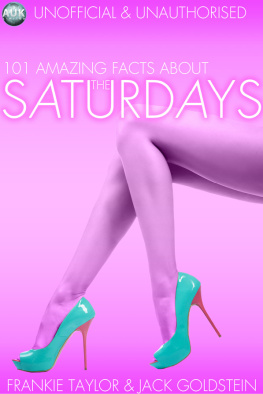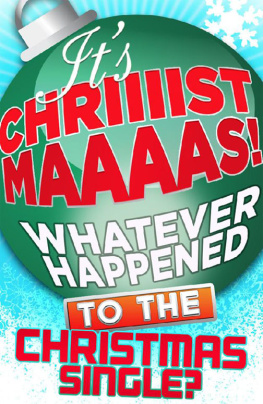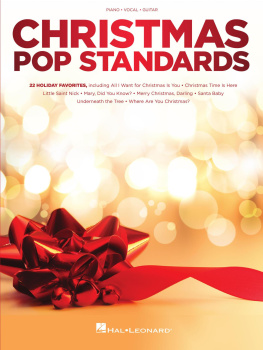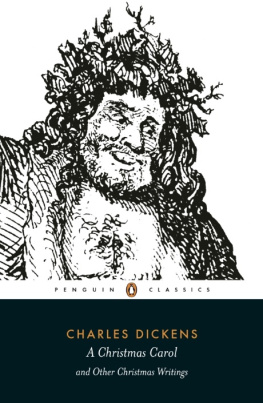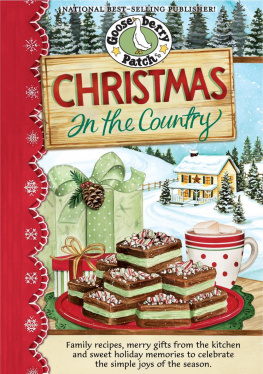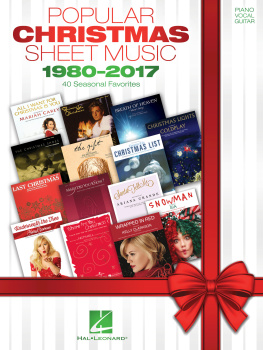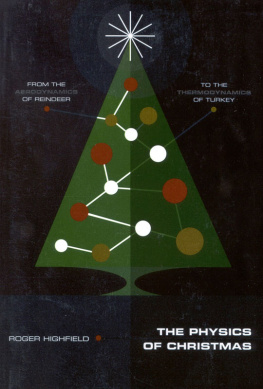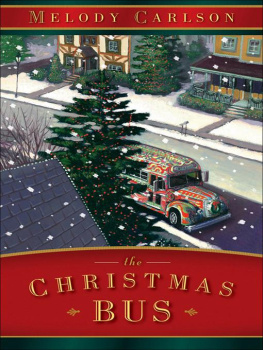Title Page
101 AMAZING FACTS ABOUT CHRISTMAS
Jack Goldstein
Publisher Information
Published in 2014 by
Andrews UK Limited
www.andrewsuk.com
The right of Jack Goldstein to be identified as the author of this work has been asserted in accordance with the Copyright, Designs and Patents Act 1998
Copyright 2014 Jack Goldstein
All rights reserved. No part of this publication may be reproduced, stored in a retrieval system, or transmitted, in any form or by any means without the prior written permission of the publisher, nor be otherwise circulated in any form of binding or cover other than that in which it is published and without a similar condition being imposed on the subsequent purchaser. Any person who does so may be liable to criminal prosecution and civil claims for damages.
All facts contained within this book have been researched from reputable sources. If any information is found to be false, please contact the publishers, who will be happy to make corrections for future editions.
Introduction
Did you know that an old tradition in Scandinavia tells of a Yule Goat who wanders around villages ensuring people have properly prepared for Christmas and demanding presents from everyone? Or that in 1659 it was illegal to celebrate Christmas in Massachusetts? What on earth is a Turducken? And how many Christmas tree farms are there in America? The answers to all of these questions and more can be found in this excellent quick-read guide to Christmas. Whether youre Santa himself, or just a typical elf interested in finding out more about this fantastic time of the year, then this book containing over one hundred fascinating facts is perfect for you!
Follow Jack Goldstein on Twitter @GoldsteinBooks
Visit Goldstein Books at www.jackgoldsteinbooks.com
An Introduction to Christmas
- Christmas is an annual event celebrated by billions of people around the world.
- The word Christmas comes from the medieval English word CristesMaesse , meaning Christs Mass, a mass being an act of worship in the church, and Christ referring to Jesus Christ.
- In the Christian calendar, Christmas is the day chosen to celebrate the birth of Jesus Christ, who followers of the religion believe to be the son of God.
- Originally, Christmas was purely a religious event. Yet in recent times an increasing number of non-Christians have celebrated the day (and the period surrounding it) as a cultural holiday.
- Most Christians celebrate Christmas Day on the 25 th of December, however there are some churches that use different days in the calendar with the 7 th of January being a popular alternative.
- The exact date of birth of the historical figure of Jesus is unknown. In the early years of the Christian church, the 25 th of December was chosen as a suitable day partly because it was close to the winter solstice, a day on which there were already pagan celebrations.
- Customs associated with Christmas vary from country to country, but generally include the giving of gifts, singing, a special meal, decorations, and a figurehead such as Father Christmas or Saint Nicholas.
- Common decorations at Christmas include a tree, cuttings of holly and mistletoe, lights or candles, garlands, wreaths and depictions of the nativity (the birth of Jesus Christ).
- Other religious names for Christmas time include Noel , The Nativity and Xmas . In the latter, the X does not actually refer to the religious symbol of the cross as some think, but the Greek letter chi (written as X); this spelling is used mostly in print, and is generally discouraged as it is an outdated form.
- The period is also referred to by the secular (meaning non-religious) terms midwinter, yule and yuletide.
The History of Christmas
- When the puritans held power in 17 th Century Britain, the singing of Christmas carols was banned - in fact, the whole concept of Christmas was outlawed!
- Across the Atlantic in Massachusetts, in 1659 it was made illegal to celebrate Christmas. If you were caught breaking this law (perhaps by singing a carol under your breath, or accidentally wishing someone a Merry Christmas) you would be fined five shillings - around 100 today taking inflation into account!
- The very first candy canes didnt have the distinctive red stripe of today - they were pure white; in 1670 a choirmaster of a cathedral is believed to have given the treats to his choirboys to keep them quiet during Christmas mass!
- How often have you heard someone comment on mince pies, pointing out that although the filling is called mincemeat, thankfully there is no actual meat inside? Well, amazingly there used to be! Strips of meat were often mixed in with the raisins, dried fruit and spices. It took until the Victorian era for people to wonder whether the pies would actually taste better without meat in them!
- Tinsel was the first ever mass-produced Christmas decoration, dating back to the 1600s. Originally it was made from extremely thin sheets of silver alloy that was cut into strips; sadly, like most silver, the tinsel would blacken over time, and being so thin was almost impossible to polish!
- It is believed the first time Christmas was celebrated in Britain was in York in 521 AD.
- The tradition of the Christmas tree was brought to Britain by Queen Victorias husband, Prince Albert, from his native Germany. One particular illustration from the newspapers of the day which depicted the royal family gathered around a tree is said to be the single biggest influence for the tradition taking hold in the country.
- Why do we hang up stockings by the fire? Legend has it that Saint Nikolaos (hell be mentioned quite a lot in this book!) had heard of the plight of three girls who were growing up with no money after their father had lost his fortune after his beloved wife died. Wishing to remain anonymous, he rode past their house on a horse, and threw three pouches of gold towards it, skilfully aiming the money down the chimney. Each pouch landed in one of each of the girls stockings... and a tradition was born.
- In Nazi Germany, the traditions of Christmas were somewhat changed by the government of the time. To take the focus away from Jesus (who was said to be King of the Jews, a race of people much hated by the Nazis), they informed people that Christmas had nothing to do with the birth of Jesus, but actually was a celebration of the Winter Solstice and the rebirth of the sun. They claimed that the swastika was an ancient symbol of the sun (admittedly there is some truth in this) and that Santa Claus was a Christian reinvention of Odin, an old Germanic God. They changed the traditional crib or nativity scene to be more pagan, with the manger replaced by deer and rabbits, and the Virgin Mary depicted as a blonde Aryan female. The Christmas tree was renamed as a light tree, and the star atop it (which had been linked to the Jewish Star of David) was replaced with a Swastika.
- If you ask someone to tell you a fact about Christmas, you will hear time and again people tell you that the image of Santa Claus was created by Coca Cola. This is absolute twaddle! Images of a fat, jolly, bearded man clothed in his traditional red costume can be found in plenty of magazines, posters and suchlike long before being used by the soft drinks company!
Christmas in America
- In 1836, Alabama became the first American state to announce Christmas as an official holiday.
- By contrast, Oklahoma was the last state to do so - they only made it a holiday in 1907, over seventy years later!
- In America, artificial trees have actually outsold real ones since 1991.
- Perhaps one of the best places to attend a Christmas service in New York is St Nicholas Church - as well as being named after old Saint Nick, it was in fact the first ever place of worship built by the Dutch in the city when it was known as New Amsterdam.
Next page

